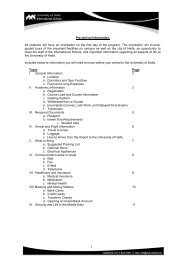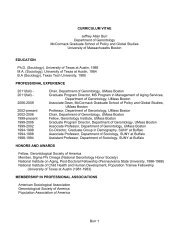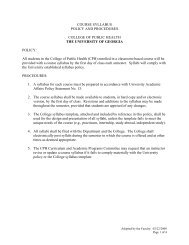MEASUREMENT MANUAL - College of Public Health - University of ...
MEASUREMENT MANUAL - College of Public Health - University of ...
MEASUREMENT MANUAL - College of Public Health - University of ...
Create successful ePaper yourself
Turn your PDF publications into a flip-book with our unique Google optimized e-Paper software.
Aggression Scale for Middle School Children<br />
DESCRIPTION<br />
RESPONSE<br />
FORMAT<br />
INTENDED<br />
RESPONDENTS<br />
SCORING AND<br />
DIRECTION<br />
RELIABILITY<br />
MISSING<br />
VALUES<br />
The Aggression Scale for middle school children was designed to measure<br />
frequency <strong>of</strong> self-reported aggressive behaviors during the week prior to the<br />
survey. The scale was developed based on student and teacher input on<br />
most frequent children’s behavior. The scale is composed <strong>of</strong> 11 items.<br />
Because two <strong>of</strong> these items measure feelings <strong>of</strong> anger, some researchers<br />
have excluded them from the scale. However, in multiple studies, all 11 items<br />
have shown a high internal consistency.<br />
Orpinas and Frankowski (2001) described three studies on the psychometric<br />
properties <strong>of</strong> the scale. We have received hundreds <strong>of</strong> requests for the scale<br />
from multiple parts <strong>of</strong> the world, including Barbados, Canada, Chile, China,<br />
England, France, Germany, Ghana, India, Italy, Lithuania, Macedonia,<br />
Malaysia, Nigeria, Oman, Pakistan, Philippines, Slovakia, Saudi Arabia,<br />
South Africa, Spain, Sweden, and Turkey, as well as from almost all states in<br />
the United States. The scale was featured in the Clinician's Research Digest,<br />
a monthly publication <strong>of</strong> the American Psychological Association that<br />
summarizes the latest research for mental health practitioners. The scale<br />
was also described in CDC’s widely-utilized compendium <strong>of</strong> measures <strong>of</strong><br />
violence-related attitudes and behaviors (CDC, 1998, 2005;<br />
http://www.cdc.gov/ncipc/pub-res/measure.htm).<br />
0 = 0 times<br />
1 = 1 time<br />
2 = 2 times<br />
3 = 3 times<br />
4 = 4 times<br />
5 = 5 times<br />
6 = 6+ times<br />
The scale was developed for middle school students, grades 6-8. The<br />
authors have used it with upper elementary and high school students.<br />
The scores are additive, and the scale ranges from 0 to 66 points. High<br />
values indicate higher frequency <strong>of</strong> perpetrating aggressive behaviors.<br />
Based on data collected from two independent samples <strong>of</strong> young<br />
adolescents (n=253 and n=8,695; Orpinas & Frankowski, 2001), the internal<br />
consistency <strong>of</strong> the scores, as measured by Cronbach’s alpha, was .87 and<br />
.88, respectively. Internal consistency scores did not vary by gender or race.<br />
Scale scores were calculated if at least eight items were nonmissing.<br />
January 2009 2
















